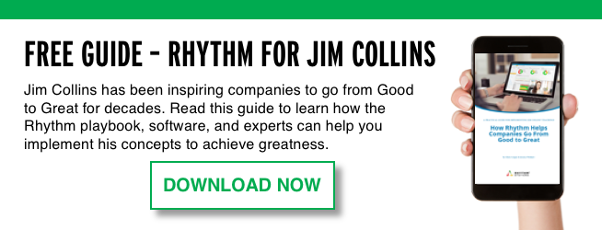In Chapter 4 of Good to Great, Collins recommends these four basic practices to create a climate where the truth is heard:
1. Lead with questions, not answers. Collins says leaders need the humility to grasp that they don’t understand everything happening in their business and they need to ask questions to gain insight. Rhythm Dashboards can let you know what questions you should be asking.
2. Engage in dialogue and debate, not coercion. Disagreement is good; it promotes healthy discussion. Patrick Thean is fond of saying that if his team members all agree with each other, then there are cost saving opportunities in the room; hearing different perspectives is the only way to make an informed decision. We call this process discuss, debate, agree.
3. Conduct autopsies, without blame. In a company that fosters accountability, one person takes responsibility for mistakes, but the whole team is responsible for learning from them.
4. Build “red flag” mechanisms. These are mechanisms that force you to stop so that you cannot ignore information you have. In Rhythm, this is your Red status on your KPIs and Priorities. This is the indication that you need to stop in your weekly meeting, face the brutal facts of what’s not working, and have a collaborative discussion to figure out how to get back on track.
Companies that went from good to great demonstrated what Collins termed the “Stockdale Paradox,” meaning that they faced the reality of the brutal facts without minimizing or sugar coating them and simultaneously had faith that they would overcome the brutal facts to be a great company in spite of them. He named the paradox after a prisoner of war who survived 8 years of torture. When Collins asked how he did it, Stockdale replied, “You must never confuse faith that you will prevail in the end - which you can never afford to lose - with the discipline to confront the most brutal facts of your current reality, whatever they might be.”
If you are looking to face the brutal facts and better live the Stockdale Paradox in your company, using Rhythm can help you get there. Our Plan Rhythm is specifically designed to create an opportunity for all team members to participate in the decision-making process, raising concerns from the front line employees and customers, and using the Discuss-Debate-Agree model of coming to consensus. This planning process creates the opportunity for your team to gather the information needed to face the brutal facts.
Then, putting the plan in Rhythm dashboards provides accountability and visibility into executing the plan on a weekly basis so that your team can easily raise a red flag when there are brutal facts to face and adjustments to be made. Finally, your quarterly plan is put into the context of your long-term company strategy so that your team is always focused on the finish line, the BHAG or visionary goal and purpose of your company. This connection to the long-term goal inspires the faith that is the other side of the Stockdale paradox; your team can execute with confidence knowing that you are willing to face the brutal facts as a company and remain committed and confident that you will reach your long-term goals together.
Photo Credit: iStock by Getty Images



 LinkedIn
LinkedIn
 Facebook
Facebook
 companies all started the path to greatness by “confronting the brutal facts of their current reality.” He gives several examples of companies that acted with discipline to seek out information about their current situation in the marketplace or future industry changes that would impact them; the great companies refused to stick their head in the sand and instead made necessary and sometimes drastic changes in light of those facts.
companies all started the path to greatness by “confronting the brutal facts of their current reality.” He gives several examples of companies that acted with discipline to seek out information about their current situation in the marketplace or future industry changes that would impact them; the great companies refused to stick their head in the sand and instead made necessary and sometimes drastic changes in light of those facts.